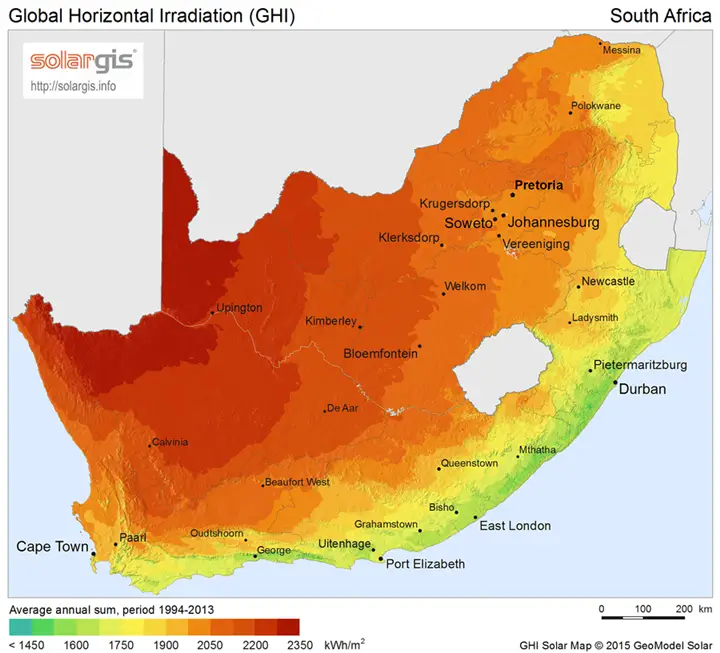There is need to have sustainable solutions for energy production in South Africa. The country which receives constant sunlight throughout the year, is now ready to embrace its own resources for power. Finding a durable and adaptable source of power throughout the country has been on the government’s agenda for years. The country is now ready to use the one resource that it never seems to lack: the sun.
Similar to many other countries, South Africa is exploring different sources of electricity and has found that renewables are the way to go. Today, most of the South African power system is still coal-driven (87.4% of net domestic electricity) and renewable energy still have a long way to go, despite the country’s potential. In fact last year, only 1% of the country’s electricity came from renewable sources.
The Minister of Energy, Tina Joeamat-Pettersson has recently revealed that the procurement of renewable energy will be accelerated and expanded. This time is crucial for South Africa as Eskom (South African electricity public utility) is failing “to keep the lights on,” (1) and additional capacities are needed in a timely manner.
In South Africa, renewable solutions for energy production in South Africa are also seen as the answer for Eskom to meet demand. Joemat-Pettersson announced that she would “make a ministerial determination for 6 300MW of renewable energy to be procured, over and above the existing 5 243MWs”(1). She added that she would “leave no stone unturned to ease the energy challenges of the country.” The government will therefore work closely with the renewable energy industry, both domestically and internationally, to assess the best available solutions for South Africa.
The Ministry of Energy and Power also made a point to address societal issues when investing in new energy sources. Being able to create jobs locally and implement the Government’s goals of transformation has to go hand in hand with investing in new power plants, explains Thembisile Majola, Deputy Minister Of Energy. According to Majola, “[w]e will leverage the benefits of the massive investment in the energy sector by ensuring that our departmental programmes display a greater degree of responsiveness to needs of our people such as the empowerment of women and the youth, whether it is through the Integrated National Electrification Programme (INEP), the roll-out of the Solar Water Heating Programme, the Independent Power Producers Programme (IPP) or the transformation of the liquid fuels sector. We will continue to strengthen interventions and programmes aimed at capacity building among vulnerable sectors to enable their meaningful participation in the energy sector in support of the country’s transformation agenda.”
Within the renewable energy sector, solar has become the most popular source in South Africa. The country is blessed with some of the world’s most consistent and reliable solar radiation. The Western and Northwestern regions can see over 340 sunny days a year and have a dry and humidity free climate, which is ideal for solar plants installations.
Major plant projects could be imagined in these key regions and some solar plant technologies offer the possibility to convey the generated power to South Africa’s major cities with efficiency.
South Africa now has to make a decision on the technology they want to implement. If photovoltaic remains an option, the country seems to have focus its attention on Concentrated Solar Power technologies, which overall offer a more robust and simple design for a competitive price. Today, the technology is spreading for its assets over photovoltaic, especially in difficult environments. The Compact Linear Fresnel (CLFR) technology is vastly growing across the world today due to its reliability and its ability to predictably generate electricity for critical peak times, according to French based company CNIM, the historic leader in supplying power plants who has specialized in the CLFR technology. CNIM is building these kinds of plants in desert environment similar to the ones in South Africa. It has proven to be a success with small and medium sizes plants and CNIM is now implementing large-scale plants using the CLFR technology. Moreover, the heat accumulated during the day can be converted into either steam or electricity when needed through a dual output system, which could be essential for South Africa’s future.
The price competitiveness is of course the main asset, but the technology, using simpler flat mirrors to reflect the sun, also allows a locally produced content. Flat mirrors can easily be produced in countries like South Africa, which can hugely benefit the regional economy. Finally, these plants are modular and scalable rapidly. They also require less land than other CSP technologies or conventional photovoltaic cell-based plants. If South Africa isn’t missing available land it does remain an asset because of the country’s growing nature preservation policies.
South Africa also has the potential to expand its photovoltaic plants and/or build new ones. The Jasper Solar Energy Project, a 96-megawatt (MW) photovoltaic power station located near Kimberley, is now fully operational and powering 80,000 homes. It has proven its success and now new technologies within the photovoltaic space are also available and being developed across the globe. China’s companies are excelling in building photovoltaic cells panels and now photovoltaic plants. Yingli Green Energy is now mastering these big scales projects throughout the country and they are also ready to export their technologies and knowledge. Yingli Solar just announced the construction of a 50 MW solar power plant in Huangshi City in the Hubei Province in an environment knowing the same problematics as South Africa – offsetting the consumption of coal and the emission of tons of carbon into the atmosphere (5).
South Africa’s investments in renewable energy, especially solar, should begin really rapidly. The government had made a point in engaging to add Eskom the possibility to meet the power demand across the country. South Africans are expecting major projects to start soon and expect to be provided with reliable and more sustainable electricity sources.

